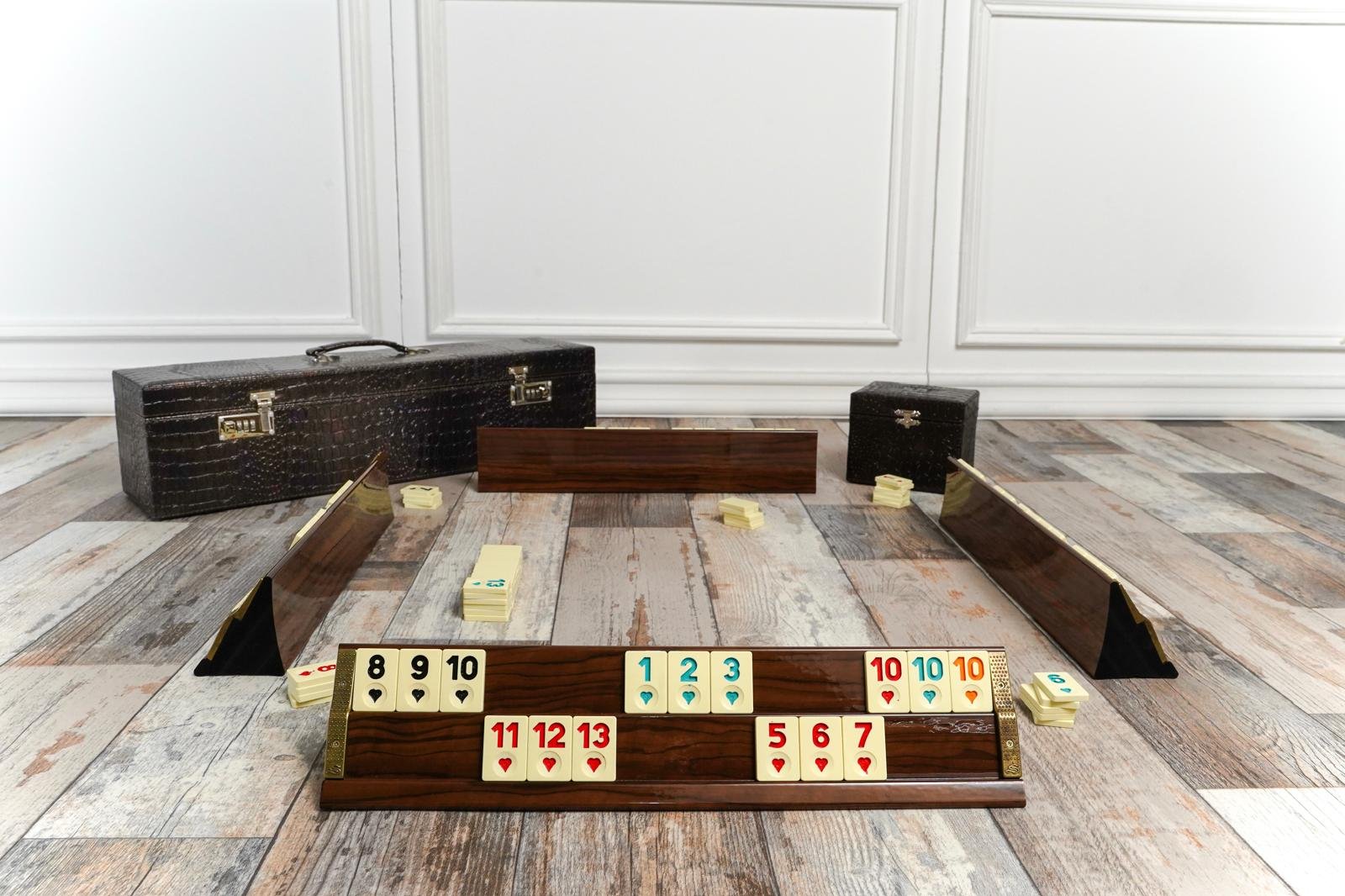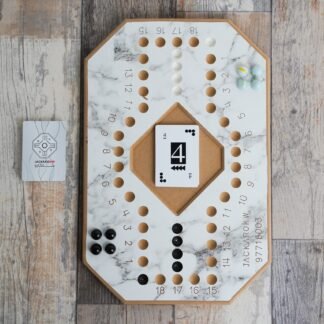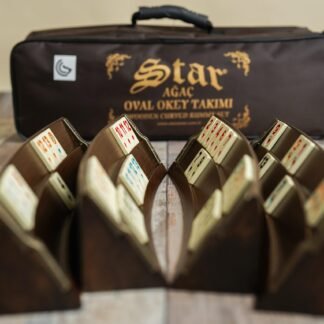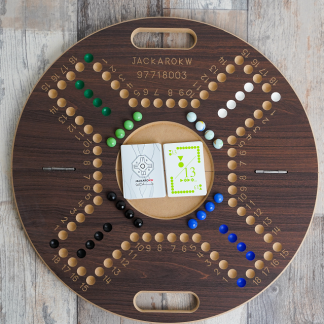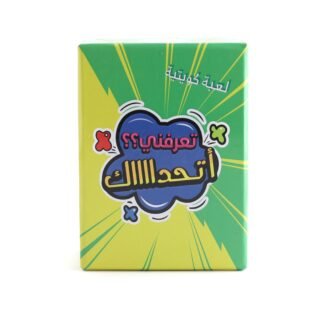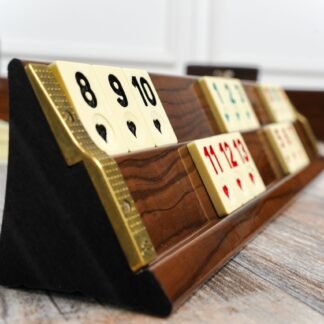Description
Rummy Game
Or Okey Game which is famous in Turkey is a group of matching-tiles game notable for similar gameplay based on matching tiles of the same rank or sequence and same suit. The basic goal in any form of rummy is to build melds which can be either sets (three or four of a kind of the same rank) or runs (three or more sequential cards of the same suit).
If a player discards a tile, making a run in the discard pile, it may not be taken up without taking all cards below the top one. The Mexican game of Conquian is considered to be ancestral to all rummy games, which itself is derived from a Chinese game called Khanhoo. The rummy principle of drawing and discarding with a view to melding appears in Chinese card games at least in the early 19th century, and perhaps as early as the 18th century.
Rummy games are popular in India. It is likely that Indian Rummy is an extension of gin Rummy and 500 Rim, which originated from the United States.
How to playing Rummy?
Object :
Be the first player to eliminate all the tiles from your rack by forming them into sets of runs and
groups. Try to keep as few points in your rack as possible. At the start of the game, you decide
how many points to reach to end the game.
Contents:
106 tiles (2 sets of tiles numbered 1 to 13 in four colors: black, red, blue, orange; 2 Jokers);
4 playing racks, pouch.
Set Up:
Place the tiles into the pouch and mix them thoroughly. Each player picks a tile; the one who
selects the highest number goes first and play proceeds in a clockwise direction. Return the
tiles to the pouch and mix them. Each player takes 14 tiles and places them on his rack.
Playing:
There are two kinds of sets:
Agroup is a set of either three or four tiles of the same number in different colors.
Arun is a set of three or more consecutive numbers, all in the same color. The number 1 is always played as the lowest number; it cannot follow the number 13.
In order to place tiles on the table, each player must make an initial play of at least 30 points in one or more sets.
These points must come from the tiles on the player’s rack and not from tiles already played on the table. A tile is worth its face value. A Joker may be used for any tile and its point value is that of the tile it represents. The penalty for holding a Joker if another player wins the round is 30 points. If a player cannot enter the round, or purposely chooses not to, the player must take a tile from the pouch and the turn ends.
After players have made their initial plays, they can also build on other sets on the table with tiles from their racks. If a player cannot add onto the other sets, the player picks a tile from the pouch and the turn ends. A player cannot lay down a tile he has just picked; he must wait until his next turn. Play continues until one player empties his rack and calls, Rummy. That ends the round and players tally their points (see Scoring). When the pouch is empty, play continues until no more plays can be made; that ends the round.
After players have made their initial plays, they can also build on other sets on the table with
tiles from their racks. If a player cannot add onto the other sets, the player picks a tile from the
pouch and the turn ends. A player cannot lay down a tile he has just picked; he must wait until
his next turn. Play continues until one player empties his rack and calls, Rummy. That
ends the round and players tally their points (see Scoring). When the pouch is empty, play
continues until no more plays can be made; that ends the round.
Time Limit:
There is a time limit of 2 minutes per player, per turn. A player who goes over the time limit must draw a tile from the pouch and his turn ends.
Incomplete Runs:
A player who unsuccessfully builds on or manipulates other sets on the table must replace the tiles in their original positions, take back the tiles he played and draw three tiles from the pouch.
Building on Sets:
A player may build onto a set in any of the following ways (or in any combination of these ways) as long as there are only legitimate sets on the table and there are no loose tiles left at the end of his turn.
The Joker:
There are two jokers in the game. They can be used for any tile in a set. A joker used in the opening set scores the value of the tiles it represents. A joker can be retrieved from a set on the table by a player who can replace it during his turn with a tile of the same numerical value and color it represents. The tile used to replace the Joker must come from a player’s rack and not from the table. In the case of a group of 3, the joker can be replaced by the tile of either of the missing colors. A joker that has been replaced must be used in the player’s same turn with 2 or more tiles from his rack to make a new set. Players cannot retrieve a joker before they have laid their initial set(s). A set containing a joker can have tiles added to it and can be split apart or have tiles removed from it. The joker has a penalty value of 30 points if it remains on a player’s rack at the end of a game.
Strategy:
The beginning of a round of Rummy may seem slow, but as the table builds up, more plays are possible. In the early stages of the game it’s a good idea to hold back some tiles so that other players open up the table and provide more opportunities for play. Sometimes it is useful to hold back the fourth tile of a group or run and lay only three, so that on the next turn you can lay a tile instead of drawing from the pouch. Keeping a joker on your rack is also a good strategy; however, you risk being caught with it (earning a penalty of 30 points) when another player goes “Rummy”.
Scoring:
After a player has cleared the rack and called “Rummy”, the losing players add up the value of the tiles they are holding on their racks. This score is totaled as a minus (negative) amount. The winner of the round receives a positive (plus) score equal to the total of all the losers’ points. At the end of each round, each player totals his minus and plus scores to produce a total score. The player with the highest score at the end of the game wins. As an aid to checking the figures, the plus score should equal the total of the minus scores in each round and in the final tally.
In the rare case that all the tiles in the pouch are used before any players goes “Rummy”, the player with the lowest count on his rack wins that round. Each loser adds up his total tile value and subtracts from it with the winner’s total. This result is scored as a minus amount. The total of these is scored to the winner as a plus amount. After scoring the round, place all the tiles back in the pouch, and begin the next round by following directions under set-up.
Winning:
The player with the highest score at the end of the game wins.


